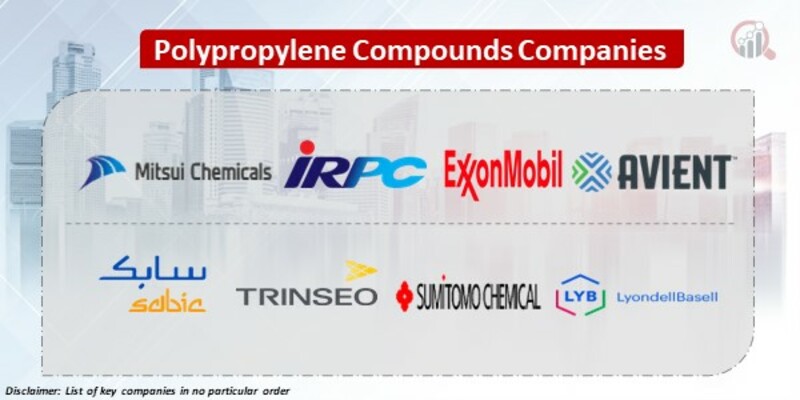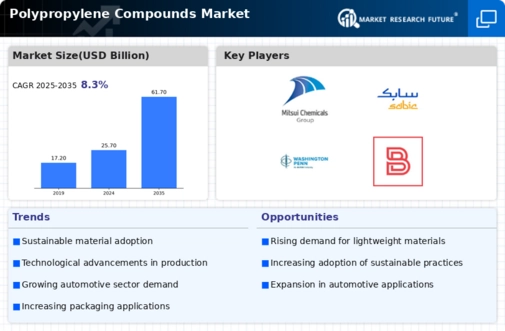Top Industry Leaders in the Polypropylene Compounds Market

The global polypropylene compounds market growth is driven by the versatility and advantageous properties of polypropylene compounds, finding applications in diverse sectors like automotive, building & construction, packaging, and electrical & electronics. However, navigating this competitive landscape demands a closer look at the strategies, key players, and recent developments shaping the market.
Strategies for Market Share Dominance:
-
Product Innovation: Leading players like LyondellBasell, ExxonMobil, and SABIC are heavily investing in R&D, developing new compound formulations with enhanced performance, sustainability, and cost-effectiveness. This includes lightweighting solutions for automotive applications, flame-retardant compounds for electronics, and bio-based polypropylene compounds for eco-conscious consumers. -
Vertical Integration: Companies are integrating backward into raw material production and forward into downstream processing to secure supply chains and optimize costs. This ensures greater control over quality and reduces dependence on external suppliers. -
Geographic Expansion: Emerging markets like Asia-Pacific and Latin America offer significant growth potential. Players are establishing production facilities and distribution networks in these regions to cater to the rising demand. -
Strategic Partnerships and Acquisitions: Collaborations with technology providers, research institutions, and downstream players are fostering innovation and market penetration. Additionally, acquisitions of smaller companies with niche expertise or regional presence are accelerating market consolidation. -
Sustainability Focus: The growing emphasis on environmental responsibility is driving the development of sustainable polypropylene compounds. This includes using recycled materials, bio-based feedstocks, and efficient manufacturing processes.
Factors Influencing Market Share:
-
Fluctuating Crude Oil Prices: As polypropylene is a petroleum derivative, its price is heavily influenced by crude oil fluctuations. This volatility can impact production costs and market stability. -
Technological Advancements: Continuous advancements in compounding technologies and additive manufacturing are opening up new application possibilities and enhancing product performance. Companies that adapt to these advancements will gain a competitive edge. -
Regional Demand Variations: The demand for polypropylene compounds varies significantly across regions due to factors like economic growth, infrastructure development, and consumer preferences. Players need to tailor their strategies to cater to specific regional needs. -
Regulatory Landscape: Stringent regulations on environmental safety and product quality can pose challenges for manufacturers. Companies with strong compliance strategies and environmentally friendly products will be better positioned to succeed.
Key Companies in the Polypropylene compounds market include
-
Mitsui Chemical, Inc.
-
IRPC Public Company Limited
-
Exxon Mobil Corporation
-
Avient Corporation
-
Japan Polypropylene Corporation
-
SABIC
-
Trinseo S.A.
-
Sumitomo Chemical Co., Ltd.
-
Washington Penn
-
Borealis AG
-
LyondellBasell Industries Holdings B.V.
-
DAEHACOM Co., Ltd.
-
GS Caltex Corporation
Recent Developments
August 2023: ExxonMobil unveils a new bio-based polypropylene compound made from sugarcane, targeting the sustainable packaging market.
September 2023: SABIC and Borealis form a joint venture to develop and commercialize next-generation flame-retardant polypropylene compounds for electrical & electronics applications.
October 2023: The International Polypropylene Association reports a 5% decline in global polypropylene production due to supply chain disruptions and the ongoing economic slowdown.
January 2024: Chevron Phillips Chemical Company announces the launch of a new line of lightweight polypropylene compounds for automotive interior components.

